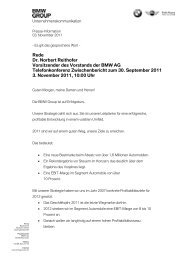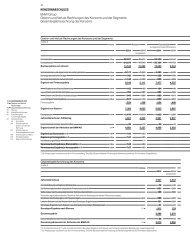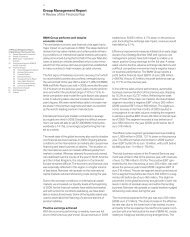Article by Prof. Dr. Hans Hunfeld (PDF, 151 KB). - BMW Group
Article by Prof. Dr. Hans Hunfeld (PDF, 151 KB). - BMW Group
Article by Prof. Dr. Hans Hunfeld (PDF, 151 KB). - BMW Group
You also want an ePaper? Increase the reach of your titles
YUMPU automatically turns print PDFs into web optimized ePapers that Google loves.
Footnotes<br />
1 It is a long time since one could get an overview of even only the<br />
relevant German-language publications <strong>by</strong> public authorities,<br />
journalists, academics, and of those publications of a methodologicaldidactic<br />
nature. And this is without reference to the “grey”<br />
publications market: various work papers, minutes, conference<br />
outcomes and the international output. Already in 1985, Klemm<br />
commented critically on this, p. 176: “The expansion (shown in the<br />
literature) of a concept is (...) not the result of theoretically cogent<br />
derivations or spectacular success in the practical realisation of a<br />
concept entitled “intercultural”. On the contrary: the (...) attempts<br />
to define what is subsumed under intercultural education are<br />
multifarious. The same holds true for descriptions of educational<br />
practice in which examples of intercultural work are communicated.<br />
“My list of references contains, apart from the cited works, those<br />
publications which attempt overviews, or give critical summaries,<br />
or classify and refer, or which seem important to me from the<br />
standpoint of my interests. At any rate, only a subjectivelydetermined<br />
selection. “For a newer, critical interim stocktaking of<br />
intercultural education, see Reich 1994.<br />
2 see Schmid, 1993, p. 200: “Immigration and multiculturalism are<br />
the norm in almost all modern societies, but a norm the normality<br />
of which involves it being repeatedly perceived as something<br />
new, as an exception or even as an anomaly.“ The European<br />
Parliament states: “The integration of the EU will lead to a further<br />
increase in crossborder mobility. It is true that this new mobility<br />
in the Community concerns other groups of people than those<br />
immigrating to the EU, ie labor which is usually more highlyqualified<br />
than most classical labor immigrants. But both trends lead to an<br />
increase and intensification of contacts between people of differing<br />
cultural, language and geographical origin. The integration of the<br />
EU and the globalisation of trade, transport and communications<br />
lead to cultural and linguistic diversity becoming the norm in the<br />
EU. Many citizens are consequently uncertain and fearful. Hence<br />
we cannot permit the integration of migrants to be only a topic for<br />
policy makers in special sectors. It has to be fought for in all areas<br />
of politics as a social policy issue par excellence. The European<br />
societies as a whole need new sustainable forms of integration”<br />
(European Parliament, PE 152.62/B, p. 5)<br />
3 see also: “... considering that the increase in intra-EU mobility<br />
and the immigration into the Community must not lead to the<br />
growth of further differentiation of education systems but on the<br />
contrary, challenges member states and with respect to their<br />
internal situations and legal systems to find new, specifically<br />
European solutions for a democratic discourse with cultural and<br />
linguistic diversity.“ (European Parliament, PE 163.895, p. 53)<br />
and “questions about society´s future are today more than ever<br />
societal questions directed at the education and training systems.<br />
If there is any one area of policy which can take on a key role in the<br />
process of integration, then it is doubtless education policy. It is true<br />
that it would be asking too much of education systems to expect<br />
them alone to cope with the future, but we cannot gain that future<br />
without a farsighted educational policy. What is at stake here is<br />
much more than merely qualifying young EU citizens for the labor<br />
market. It is just as much an issue of strengthening, implementing<br />
and expanding minority protection rights, waking understanding<br />
for cultural and linguistic diversity, developing respect for others,<br />
fostering tolerance and abolishing discrimination. The main issue is<br />
to give the notion of EU citizenship concrete shape and to breathe<br />
life into it, especially for young people.” (European Parliament, PE<br />
152.262/B, p. 5)<br />
4 see Roth 1991, p. 38: “In the multicultural society, dialogue´s<br />
function as an appeal has gained a fundamentally new currency.<br />
Dialogue with other cultures is not an event which occurs only<br />
during trips to other countries or in addressing the so-called Third<br />
World, but begins in one´s own country: as both opportunity<br />
and problem – and at any rate, as a fact which there is no getting<br />
around. Hence there is a noticeable increase in “dialogues” in<br />
intercultural thinking and work. Here too, this increase ought not<br />
to be put prematurely on one side as concept-inflation, but seen<br />
as expressing an urgent necessity. And as intercultural education<br />
neither can, nor wants to, ignore this concept, it seems obvious<br />
to look and see whether “dialogue” can be used to ground the<br />
discipline. Because the concepts of dialogue and consciousness<br />
which are not foreign to educational thought per se, acquire special<br />
meaning in intercultural education for the theoretical justification<br />
and legitimation of teaching activity in view of the living conditions<br />
of a multicultural society.”<br />
5 One should note: “The question of whether the envisaged<br />
learning outcome: improving the capacity for intercultural<br />
10<br />
communication, can be actually achieved <strong>by</strong> a corresponding<br />
learning program, has to remain unanswered. The rise in racist<br />
tendencies in Germany and other parts of Europe and the world<br />
in general illustrate what can be the enormous stubbornness of<br />
stereotypical attitudes towards everything that seems foreign. This<br />
fact alone gives rise to doubt as to whether a sensitivity program<br />
can do more than to reach those persons who have already<br />
reflected on their basic stance. One has to want to understand<br />
and no amount of direction can compel volition. Thus it does not<br />
seem appropriate to entertain too much idealism as regards the<br />
development of didactic materials for intercultural communication.<br />
But particularly given the existing problems, every attempt should<br />
be made to assist those willing to learn, as indeed us ourselves, and<br />
to question stereotypical thinking.” (Burghart 1994, p. 64)<br />
6 Some fundamental comments here are offered <strong>by</strong> Wierlacher<br />
1993.<br />
7 Some fundamental comments <strong>by</strong>: Greenblatt 1994, Kristeva<br />
1990 and Todorov 1982.<br />
8 see Luhmann/Fuchs 1989, p. 7.<br />
9 see Brenner 1989, p. 45: “The foreigner always remains strange:<br />
the familiarity which is the basis for understanding cannot occur<br />
because lifestyles are always defined <strong>by</strong> demarcation and not <strong>by</strong><br />
assimilation. In such demarcation processes, lifestyles do have to<br />
reflect on their own particularity <strong>by</strong> including the Other, but precisely<br />
for that reason, it is located as the strange and unfamiliar.” The<br />
observable experience of the boundaries of understanding the<br />
Other give rise to two alternative ways of thinking and acting: one<br />
can see the boundaries as not insuperable and thus try to extend<br />
the limited ability to understand; or one can see them largely as<br />
insuperable, accepting them as a basic hindrance to understanding<br />
the Other, and thinking and acting on that acceptance. Leaving<br />
aside armchair talk and street slogans and politicians´speechifying<br />
aimed at mindless acclamation, the current debate on foreigners<br />
is indeed oriented towards those alternatives, if I understand it<br />
correctly.<br />
10 see here also Kristeva 1990, p. 213: “a paradoxical society is<br />
coming into being, a community of foreigners, who accept each<br />
other to the degree that they perceive each other as foreigners.”<br />
11 see here Hinnenkamp 1994a, p. 3: “naturally, cultural, social<br />
and linguistic sciences offer clearly-defined concepts of culture:<br />
hermeneutic, structuralist, semiotic, cognitive, analytic etc. but one<br />
thing should be clear: Culture is not a simple quantity per se, nor is<br />
it static.It needs no national or societal consensus. Nor is it reducible<br />
to an internalised value system or to a habitus tailormade for people.<br />
Culture is many of (these) facets and modes of expression.”<br />
12 That applies also to the <strong>by</strong> now established concept: “In the<br />
enlightened current consciousness of western societies and in<br />
the political and scientific manifestations of that consciousness,<br />
the idea of interculturalism has established itself as a value which<br />
is hardly ever questioned. Too close are its ties to central political,<br />
cultural and ethical ideas for criticism of interculturalism not to<br />
run the danger of moral disapprobation. It is doubtless one of the<br />
most precious achievements of enlightened thought to have put<br />
paid to contempt of the outsider, at least in theory and in the name<br />
of humanity. But it is exactly this tradition which has left behind a<br />
fund of unresolved issues. An interculturalism in thought and deed,<br />
unenlightened as to its own constitutive conditions, threatens to fall<br />
victim to these issues.” (Brenner 1989, p. 37)<br />
13 “Language embraces more than anything else in people, it<br />
embraces the whole human race. It is precisely in its capacity to<br />
keep races apart that it unites the variety of the individualisms <strong>by</strong><br />
means of the mutual comprehension of foreign speech, without<br />
doing them harm.” (Humboldt, p. 117)<br />
14 see here the comments cited <strong>by</strong> Roth 1991, p. 46: “Intercultural<br />
education is seen not as a pedagogic task in its own right, which is<br />
to be performed in addition to the accustomed things which have<br />
been called for to date, but as a general principle, which has to be<br />
given due recognition in all areas of our education system“ (Hegele,<br />
1986, 158). “We would want intercultural education to become<br />
superfluous as a special area in general education, because the<br />
multiethnic and multicultural dimension is included in thinking<br />
about general education” (Essinger and Kula, 1987, 5) “Intercultural<br />
education is not a (new) special type of education, and no new<br />
definition of education. But intercultural education will be able to<br />
redefine the educational task.” (Borelli, 1986, p. 24)





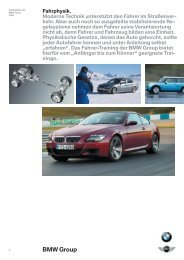

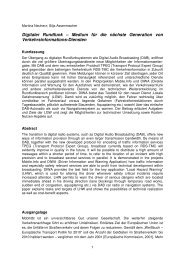
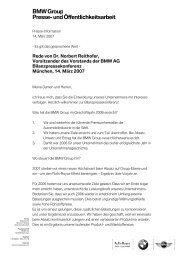
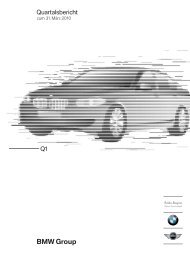

![Vollständiger Bericht [PDF] - BMW Group](https://img.yumpu.com/20706531/1/190x238/vollstandiger-bericht-pdf-bmw-group.jpg?quality=85)
